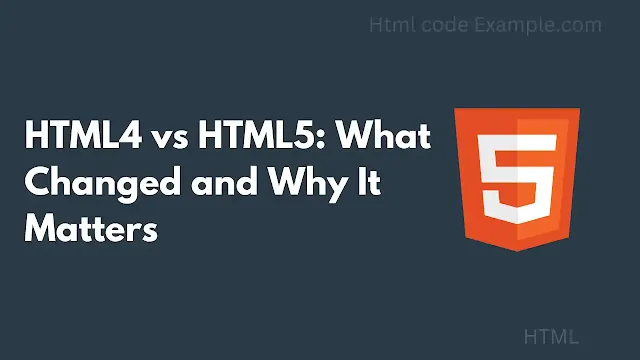If you're new to web development, you might wonder: What's the difference between HTML4 and HTML5? Why do developers always recommend HTML5? Let's break it down in plain language—no complicated terms, just straightforward explanations.
What Is HTML?
HTML (HyperText Markup Language) is the standard code used to create websites. It structures content like text, images, and links so browsers can display them correctly. Over the years, HTML has improved, with HTML5 being the latest and most advanced version.
Key Differences Between HTML4 and HTML5
Doctype Declaration – Much Cleaner in HTML5
In HTML4, the doctype (a line that tells the browser which HTML version you're using) was long and confusing:
<!DOCTYPE HTML PUBLIC "-//W3C//DTD HTML 4.01 Transitional//EN" "http://www.w3.org/TR/html4/loose.dtd">
In HTML5, it's just one simple line:
<!DOCTYPE html>
Why this matters: No need to memorize complex code—just type <!DOCTYPE html> and you're good to go.
Semantic Tags – Better Structure & Readability
HTML4 relied on generic <div> tags for everything, making code messy:
<div id="header">...</div>
<div id="nav">...</div>
<div class="article">...</div>
HTML5 introduced meaningful tags that describe their purpose:
<header>– Top section of a webpage<nav>– Navigation menu<article>– Main content (like a blog post)<section>– Groups related content<footer>– Bottom section of a page
Example (HTML5 way):
<header>...</header>
<nav>...</nav>
<article>...</article>
Why this matters: Easier to read, better for SEO, and helps screen readers understand page structure.
Built-in Audio & Video
In HTML4, playing videos required plugins like Flash, which was slow and often crashed:
<object data="video.mp4" type="video/mp4">
<param name="autoplay" value="false">
</object>
HTML5 introduced native <video> and <audio> tags:
<video controls>
<source src="video.mp4" type="video/mp4">
</video>
<audio controls>
<source src="song.mp3" type="audio/mpeg">
</audio>
Why this matters: Faster loading, better mobile support, and no more security risks from Flash.
Smarter Forms – Less JavaScript Needed
HTML4 had basic input fields like text and checkboxes. HTML5 added helpful input types:
type="email"– Checks if the input is a valid emailtype="date"– Shows a calendar pickertype="number"– Only allows numberstype="range"– A draggable slider
Example:
<!-- HTML4 (basic text field) -->
<input type="text" name="email">
<!-- HTML5 (automatically checks for valid email) -->
<input type="email" name="email" required>
Why this matters: Less coding for validation, better user experience.
Local Storage – Websites Work Offline
HTML5 allows websites to store data in the browser, so some features keep working even without internet:
- Local Storage – Saves data permanently (until manually cleared).
- Session Storage – Temporary storage (clears when the tab closes).
Example (Saving a username):
localStorage.setItem("username", "JaneDoe"); // Save
let user = localStorage.getItem("username"); // Retrieve
Why this matters: Apps like Google Docs can work offline.
Canvas & SVG – Better Graphics Without Plugins
In HTML4, complex animations needed Flash. HTML5 introduced:
<canvas>– Draw shapes, animations, and games with JavaScript.<svg>– Sharp, scalable graphics (great for logos and icons).
Example (Drawing a red circle with Canvas):
<canvas id="myCanvas" width="200" height="100"></canvas>
<script>
let canvas = document.getElementById("myCanvas");
let ctx = canvas.getContext("2d");
ctx.fillStyle = "red";
ctx.beginPath();
ctx.arc(100, 50, 40, 0, 2 * Math.PI);
ctx.fill();
</script>
Why this matters: No more slow plugins—games and animations run smoothly in the browser.
Improved Mobile Support
HTML5 was designed for modern devices, making websites load faster and work better on phones and tablets.
Should You Still Use HTML4?
No! HTML5 is faster, more powerful, and supported by all modern browsers. HTML4 is outdated and lacks key features needed today.
Final Summary
- ✅ Simpler code – Shorter doctype, meaningful tags
- ✅ No more Flash – Built-in video/audio support
- ✅ Better forms – Automatic validation
- ✅ Works offline – Local storage capabilities
- ✅ Smoother graphics – Canvas and SVG
